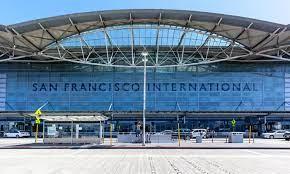
SFO Runways Sinking Faster Compared To Other Coastal Airports
California
: After measuring minute elevation changes on runways at 15 coastal airports around the United States, researchers found that of airport runways sinking or subsiding, San Francisco (SFO) tops the subsidence chart at nearly 10 millimeters (0.4 inches) per year, while Los Angeles International Airport (LAX) is the slowest.
America's crumbling roads and sagging bridges have garnered attention over the past few years, prompting the passing of the Infrastructure Investment and Jobs Act in 2021. But the nation's runways are also feeling their age, posing serious hazards to the millions of travelers who fly every day, researchers say.
"The funding to maintain airport infrastructures is quite limited, so many are getting dilapidated," said Oluwaseyi Dasho, an environmental hazard specialist at Virginia Tech.
Dasho and his advisor, Manoochehr Shirzaei, wanted to better understand how coastal airports' runways, roads, and other transportation infrastructure are fairing. "U.S. airport infrastructure needs attention, especially focusing on runways," Dasho said. They measured subsidence, or the slow sinking of the ground surface, because cracks or bulging on runways can cause serious accidents for passengers and flight crews. Shifts that seem small on an annual basis can quickly add up.
In a new study to be presented on 14 December at AGU's Annual Meeting in San Francisco, researchers surveyed the infrastructure of 15 coastal airports in the United States over a 7-year time frame (2015-2022). They used the European Space Agency's Sentinel-1 radar satellite to measure surface elevation at an unprecedented submillimeter scale-ideal for measuring small-scale changes in shifting infrastructure.
"It's the first subsidence data set ever created for U.S. airports runways," said Shirzaei, an environmental security expert at Virginia Tech, adding that such vertical accuracy can allow them to measure "very tiny deformation, such as the deformation of the ground from thawing and freezing."
Subsidence rates varied among the 15 sites studied, but all had observable changes. Of these airports, San Francisco International Airport had the fastest subsidence rate of -9.6 millimeters per year (0.38 inches per year). In comparison, Los Angeles International Airport had the slowest rate (1.7 millimeters per year, or around 0.07 inches per year).
Out of the nearly 7 million square meters (1,718 acres) of runway analyzed, the researchers found that more than 96pc were at low risk of damage due to subsidence, and 0.3pc of runway areas (about 13,825 square meters, or 3.5 acres) are at high or very high risk of damage, notably at Ronald Regan International Airport in Arlington, Va., and two Florida airports, Tampa International and Orlando International Airport.
While the infrastructure bill allocated billions of dollars for updating U.S. infrastructure, Dasho pointed out that the demand and need for maintenance updates far exceeds this budget. This research might help policymakers allocate limited funds.
"Prioritizing infrastructure allows equitable transportation infrastructure, particularly enabling underserved and socially vulnerable communities to develop and apply adaptation and mitigation strategies in the face of climate change," he said.
Shirzaei agreed, adding, "This technology will tell you very clearly which infrastructure and where is in the worst condition and needs attention first."
-B
Legal Disclaimer:
MENAFN provides the
information “as is” without warranty of any kind. We do not accept
any responsibility or liability for the accuracy, content, images,
videos, licenses, completeness, legality, or reliability of the information
contained in this article. If you have any complaints or copyright
issues related to this article, kindly contact the provider above.


















Comments
No comment